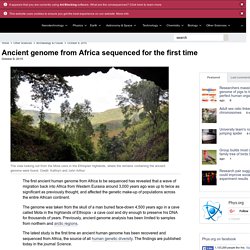

Teeth from China reveal early human trek out of Africa. S.

Xing and X-J. Wu These 47 human teeth, dated to 80,000-120,000 years ago, were found in a limestone cave system in Daoxian, China. Teeth from a cave in south China show that Homo sapiens reached China around 100,000 years ago — a time at which most researchers had assumed that our species had not trekked far beyond Africa. Nature Podcast María Martinón-Torres explains how a set of ancient teeth challenges ideas of early human migration “This is stunning, it’s major league,” says Michael Petraglia, an archaeologist at the University of Oxford, UK who was not involved in the research. Limestone caves pockmark Daoxian County in Hunan Province, China. The teeth are unquestionably those of H. sapiens, says María Martinón-Torres, a palaeoanthropologist at University College London who co-led the study with colleagues Wu Liu and Xiu-jie Wu at the Institute of Vertebrate Paleontology and Paleoanthropology in Beijing.
Ancient genome from Africa sequenced for the first time. The first ancient human genome from Africa to be sequenced has revealed that a wave of migration back into Africa from Western Eurasia around 3,000 years ago was up to twice as significant as previously thought, and affected the genetic make-up of populations across the entire African continent.

The genome was taken from the skull of a man buried face-down 4,500 years ago in a cave called Mota in the highlands of Ethiopia - a cave cool and dry enough to preserve his DNA for thousands of years. Previously, ancient genome analysis has been limited to samples from northern and arctic regions. The latest study is the first time an ancient human genome has been recovered and sequenced from Africa, the source of all human genetic diversity. The findings are published today in the journal Science. Researchers describe the findings as evidence that the 'backflow' event was of far greater size and influence than previously thought. "Africa is a total melting pot.
Round 2. Modern Humans. Civilization. Progressive Technology. Language. Neandertal Demise: An Archaeological Analysis of the Modern Human Superiority Complex. Neandertals are the best-studied of all extinct hominins, with a rich fossil record sampling hundreds of individuals, roughly dating from between 350,000 and 40,000 years ago.

Their distinct fossil remains have been retrieved from Portugal in the west to the Altai area in central Asia in the east and from below the waters of the North Sea in the north to a series of caves in Israel in the south. Having thrived in Eurasia for more than 300,000 years, Neandertals vanished from the record around 40,000 years ago, when modern humans entered Europe. Modern humans are usually seen as superior in a wide range of domains, including weaponry and subsistence strategies, which would have led to the demise of Neandertals.
Figures Citation: Villa P, Roebroeks W (2014) Neandertal Demise: An Archaeological Analysis of the Modern Human Superiority Complex. Editor: Michael D. Received: February 26, 2014; Accepted: April 7, 2014; Published: April 30, 2014 Copyright: © 2014 Villa, Roebroeks. Introduction. The myth of the eight-hour sleep. Image copyright Other We often worry about lying awake in the middle of the night - but it could be good for you.

A growing body of evidence from both science and history suggests that the eight-hour sleep may be unnatural. In the early 1990s, psychiatrist Thomas Wehr conducted an experiment in which a group of people were plunged into darkness for 14 hours every day for a month. It took some time for their sleep to regulate but by the fourth week the subjects had settled into a very distinct sleeping pattern.
They slept first for four hours, then woke for one or two hours before falling into a second four-hour sleep. Though sleep scientists were impressed by the study, among the general public the idea that we must sleep for eight consecutive hours persists. Cancer 'drove black skin evolution' - BelfastTelegraph. 01 of 2 26 February 2014 Scientists believe dark skins appeared more than a million years ago to prevent our African ancestors dying from skin cancer.

The change occurred after ancient humans shed most of their body hair and ventured out into the sun-drenched African savannah. Previously, like present-day chimpanzees, they would have had pale skin under their hair. New evidence indicates that the lethal effects of the sun's rays may have exerted powerful selection pressure on early humans between 1.2 and 1.8 million years ago. Only those individuals with darker, more protected, skin would have escaped dying young from skin cancer and been free to pass their genes onto future generations. The theory has been rejected up to now because it was thought skin cancer rarely killed people at a young enough age to affect reproduction.
The Upper Paleolithic Revolution. Anatomically modern humans first emerged around 100,000 years ago.

However, thereafter there seems to have followed a period of around 60,000 years when the lifestyle of the modern humans changed little from that of their predecessors. It was not till around 40,000 years ago that the archaeological record reveals the emergence of technical and social advances which a modern human can understand as fundamentally like our own. This dramatic change is known as the Upper Palaeolithic Revolution.